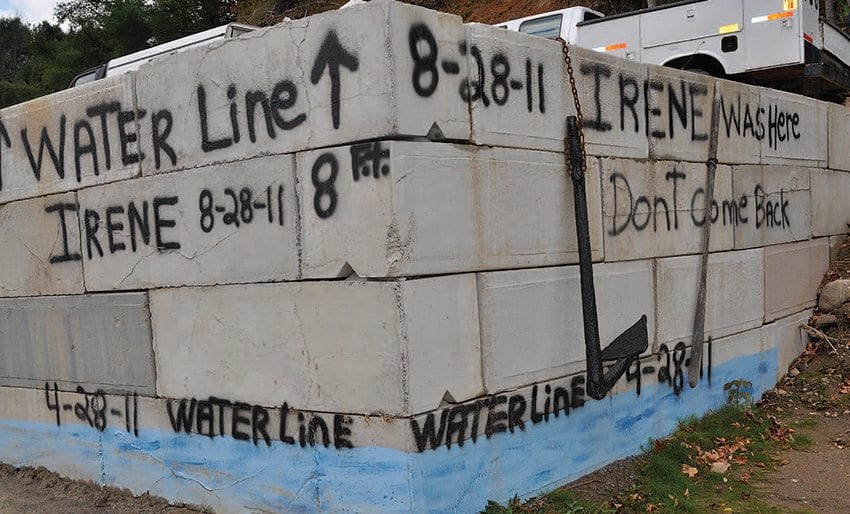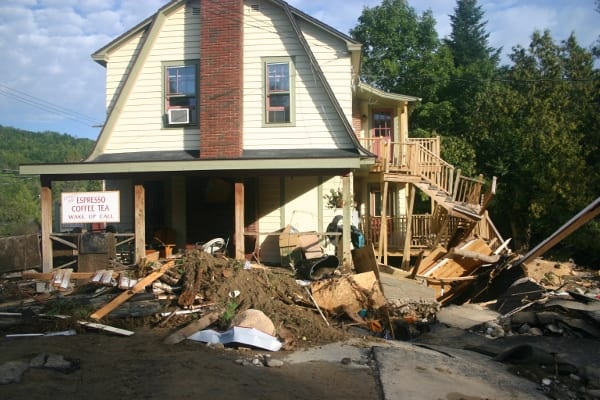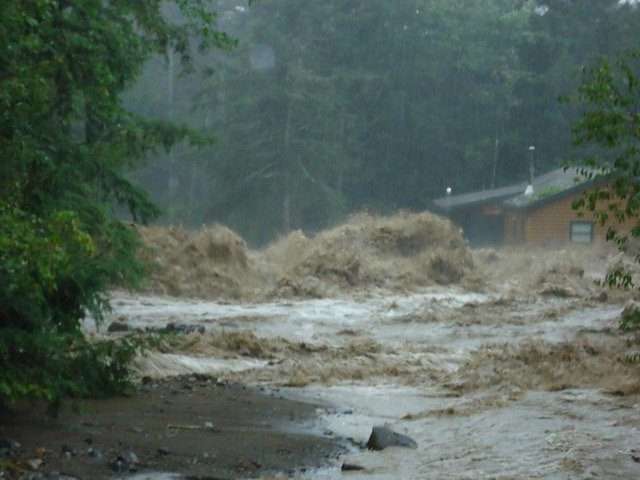
By Tim Rowland
With the Ausable River valley, ironically enough, under a flood watch from the remnants of Tropical Storm Fred, and just before Henri materialized, residents of Keene and Jay gathered at the Keene Valley Congregational Church on Aug. 18 to commemorate Hurricane Irene, which a decade ago simultaneously devastated and united a community with flood waters so high they exceeded the National Weather Service’s ability to measure them.
The storm wreaked havoc on homes, businesses, fire departments and libraries. It tore great scars on the venerable mountains themselves, made raging rivers of babbling brooks and like a great sword carved up communities, undercutting homes and bulldozing mountains of debris, leaving people stranded and aghast at what they had just witnessed.
In a short documentary by Carol Blakeslee-Collin and Jimm Collin on the Aug. 28, 2011, storm, musician Martha Gallagher said the river washed away so much of her property that her tax assessment actually decreased.
BECOME AN EXPLORER: Support independent Adirondack journalism
Marie-Anne Ward, board president of the Wells Memorial Library in Upper Jay Library at the time, was working at The Birch Store in Keene Valley when she received an urgent call with the instructions to “grab whoever is still there, turn out the lights and leave.” She was the last one out before Irene claimed Route 73.
But 12 miles up the road, the historic, 1906 library was in trouble. Ward, her board members and residents watched helplessly as the waters rose, ruining books on the lower shelves. When the waters receded, they began pulling the books out of the muck and tossing them in the front yard. It started as a pile and ended as a mountain. “For anyone who loves to read, it was heartbreaking,” Ward said.
Assessing the damage, the plaster walls and solid hickory shelving of the original construction survived, but the addition with its modern drywall and particle board shelving did not. And the library had only $16,000 in insurance. Before long though, that number was dwarfed by donations from around the world. Children’s book author Kate Messner raised funding, and The Bookstore Plus in Lake Placid facilitated donations. The story was told around the world, and a box of books arrived all the way from Germany. “Like a phoenix rising, we opened in January,” Ward said.

Throughout the valley too, help began to arrive. Neighbors pitched in. Strangers materialized out of the blue to help. Impromptu fundraisers were pulling in hundreds of thousands of dollars. In less than a week, the Adirondack Foundation was writing checks made possible by generous donations. When it was needed most, the government came through, from highway workers to Gov. Andrew Cuomo himself, who sliced through red tape like Irene had scoured Gulf Brook. Even FEMA, eventually, came through.
“People showed up out of nowhere,” said Keene resident Marcy Neville. “They knew who was likely to have been hit, and they went to see what they could do.”
“It was a crushing blow, but the recovery was extraordinary,” said Peter Slocum of Keene.
Today, Irene’ memory is still fresh, and work that it inspired continues, from the hardening of Gulf Brook in Keene to construction of an emergency shelter in Au Sable Forks to a restructuring of the East Branch floodplain and riverbed.

Looking back at Irene
Writing in our sister site, the Adirondack Almanack, author Lorrain Duvall writes about the flooding of Styles Brook near her home during Irene. READ MORE
PLUS: MORE IRENE STORIES in the Almanack
Styles Brook flooding in 2011 during Tropical Storm Irene. Photo provided by Lorraine Duvall
“We can’t stop another Irene, but we can make the river as resilient as possible,” said Kelley Tucker, Executive Director of the Ausable River Association. AsRA is, this month, starting work on the first phase of a 13-part project to reshape the river into a more natural state, after being widened and straightened more than a century ago to accommodate the flow of logs from the forests to the mills.
For Tucker, who had just moved to Upper Jay two years prior to the flood, Irene was both a catastrophe and a scientific wonder. “I got to watch the river that night to try to understand what was going on,” she said.
The NWS gauge in Au Sable Forks typically measures flow below the confluence of the East and West branches at 400 cubic feet per second. Modest floods will produce a flow of 12,000 cfs. Irene broke through the gauge’s 44,000 cfs capacity and kept right on going to an estimated 50,000 cfs.
“Every vulnerability was taken advantage of; if there was a weak spot, Irene found it,” Tucker said. Tiny culverts and floodplain development proved to be two critical shortcomings, and two areas that have the potential for improvement, she said.
But along with science, residents still see their river as art, as poetry and as a part of life. Author Lorraine Duvall referenced Swami Omkarananda, who said that nature and the world around us is always “throbbing with the divine.”
“Our river is always throbbing with the divine,” Duvall said. “Sometimes it just throbs a little more than others.”
More to Explore
Subscribe to print/digital issues of Adirondack Explorer,
delivered 7 times a year to your mailbox and/or inbox
"later" - Google News
August 22, 2021 at 05:39PM
https://ift.tt/2WdlIHS
Looking back at Irene, 10 years later - Adirondack Explorer
"later" - Google News
https://ift.tt/2KR2wq4
Bagikan Berita Ini















0 Response to "Looking back at Irene, 10 years later - Adirondack Explorer"
Post a Comment